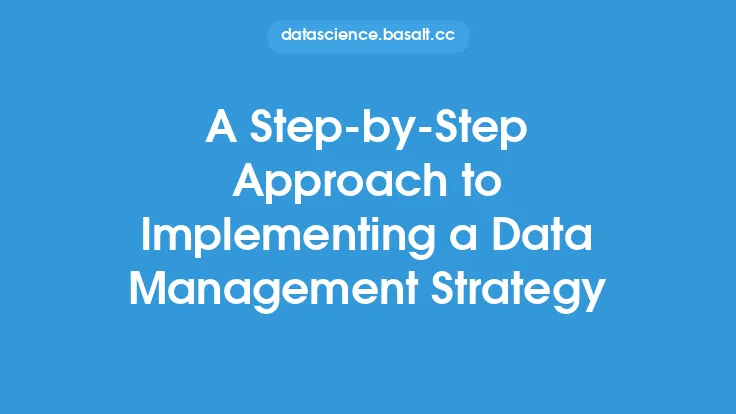Developing a data preparation strategy is a crucial step in ensuring the success of any data analysis project. It involves planning, designing, and implementing a set of processes and procedures to transform raw data into a usable format for analysis. A well-planned data preparation strategy can help organizations to improve the quality of their data, reduce errors, and increase the efficiency of their data analysis processes.
Introduction to Data Preparation Strategy
A data preparation strategy is a comprehensive plan that outlines the steps and procedures to be followed in preparing data for analysis. It takes into account the organization's data management policies, data quality standards, and the requirements of the data analysis project. The strategy should be tailored to the specific needs of the organization and should be flexible enough to accommodate changing data management requirements. A good data preparation strategy should include procedures for data collection, data cleaning, data transformation, data integration, and data storage.
Key Components of a Data Preparation Strategy
There are several key components that should be included in a data preparation strategy. These include:
- Data governance: This refers to the policies and procedures that govern the management of data within the organization. It includes data quality standards, data security policies, and data access controls.
- Data quality: This refers to the processes and procedures used to ensure that the data is accurate, complete, and consistent. It includes data validation, data cleansing, and data normalization.
- Data architecture: This refers to the design and structure of the data management system. It includes the data models, data warehouses, and data marts.
- Data tools and technologies: This refers to the software and hardware used to manage and analyze the data. It includes data integration tools, data transformation tools, and data visualization tools.
- Data skills and training: This refers to the skills and training required by the data analysis team to prepare and analyze the data. It includes training on data management tools, data analysis techniques, and data visualization best practices.
Steps to Develop a Data Preparation Strategy
Developing a data preparation strategy involves several steps. These include:
- Assessing the organization's data management requirements: This involves identifying the data management needs of the organization and assessing the current data management capabilities.
- Defining the data preparation goals and objectives: This involves defining the goals and objectives of the data preparation strategy and identifying the key performance indicators (KPIs) to measure its success.
- Identifying the data sources and systems: This involves identifying the data sources and systems that will be used to collect and manage the data.
- Designing the data architecture: This involves designing the data models, data warehouses, and data marts that will be used to store and manage the data.
- Selecting the data tools and technologies: This involves selecting the software and hardware that will be used to manage and analyze the data.
- Developing the data governance policies: This involves developing the policies and procedures that will govern the management of data within the organization.
- Training the data analysis team: This involves providing training and support to the data analysis team to ensure that they have the skills and knowledge required to prepare and analyze the data.
Best Practices for Implementing a Data Preparation Strategy
There are several best practices that should be followed when implementing a data preparation strategy. These include:
- Using data quality metrics to measure the success of the data preparation strategy
- Implementing data validation and data cleansing procedures to ensure the accuracy and completeness of the data
- Using data transformation and data integration tools to transform and integrate the data
- Implementing data security policies and procedures to protect the data from unauthorized access
- Providing training and support to the data analysis team to ensure that they have the skills and knowledge required to prepare and analyze the data
- Continuously monitoring and evaluating the data preparation strategy to identify areas for improvement
Common Challenges in Implementing a Data Preparation Strategy
There are several common challenges that organizations may face when implementing a data preparation strategy. These include:
- Data quality issues: Poor data quality can make it difficult to prepare and analyze the data.
- Data complexity: Complex data structures and formats can make it difficult to prepare and analyze the data.
- Limited resources: Limited resources, including budget and personnel, can make it difficult to implement a data preparation strategy.
- Lack of skills and training: A lack of skills and training can make it difficult for the data analysis team to prepare and analyze the data.
- Changing data management requirements: Changing data management requirements can make it difficult to implement and maintain a data preparation strategy.
Conclusion
Developing a data preparation strategy is a crucial step in ensuring the success of any data analysis project. It involves planning, designing, and implementing a set of processes and procedures to transform raw data into a usable format for analysis. By following the steps and best practices outlined in this article, organizations can develop a comprehensive data preparation strategy that meets their data management needs and improves the quality of their data.





